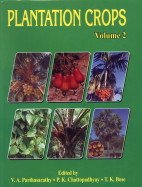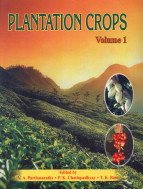parthasarathy chattopadhyay bose (3 resultados)
Tipo de artículo
- Todo tipo de artículos
- Libros (3)
- Revistas y publicaciones
- Cómics
- Partituras
- Arte, grabados y pósters
- Fotografías
- Mapas
-
Manuscritos y
coleccionismo de papel
Condición
- Todo
- Nuevos
- Antiguos o usados
Encuadernación
- Todo
- Tapa dura
- Tapa blanda
Más atributos
- Primera edición
- Firmado
- Sobrecubierta (1)
- Con imágenes del vendedor
- Sin impresión bajo demanda
Ubicación del vendedor
Valoración de los vendedores
-
Plantation Crops Volume 2 (2)
Publicado por Bio-Green Books, 2005
ISBN 10: 8185971919ISBN 13: 9788185971919
Librería: HPB-Red, Dallas, TX, Estados Unidos de America
Libro
Hardcover. Condición: Good. Connecting readers with great books since 1972! Used textbooks may not include companion materials such as access codes, etc. May have some wear or writing/highlighting. We ship orders daily and Customer Service is our top priority!.
-
Plantation Crops : Vol : I
Publicado por Naya Udyog, Kolkata, 2006
ISBN 10: 8185971978ISBN 13: 9788185971971
Librería: Vedams eBooks (P) Ltd, New Delhi, India
Libro
Hardbound. Condición: As New. New. Contents Tea/A. Deka P.C. Deka and T.K. Mandal 1. Introduction. 2. Area and production. 3. Composition and uses. 4. Economic importance and health benefits. 5. Origin and history. 6. Botany. 7. Genetics and breeding. 8. Biotechnology. 9. Climate and soil. 10. Growth and development. 11. Propagation. 12. Cultivation. 13. Diseases and pests. 14. Future thrusts. 15. References. Coffee/H.L. Sreenath and N.S. Prakash 1. Introduction. 2. Area and production. 3. Composition and uses. 4. Origin and history. 5. Botany. 6. Classification and cultivars. 7. Genetics and breeding. 8. Biotechnology. 9. Climate and soil. 10. Growth and development. 11. Propagation. 12. Cultivation. 13. Diseases and pests. 14. Harvesting and crop processing. 15. Future thrusts. 16. References. Cocoa/D. Balasimha 1. Introduction. 2. Area and production. 3. Composition and uses. 4. Origin and history. 5. Botany. 6. Classification and cultivars. 7. Genetics and breeding. 8. Biotechnology. 9. Climate and soil. 11. Growth and development. 12. Propagation. 13. Cultivation. 14. Diseases and pests. 15. Yield and quality. 16. Processing. 17. Future thrusts. 18. References. Rubber/Y. Annamma Varghese Saji T. Abraham and Jayashree Madhavan 1. Introduction. 2. Area and production. 3. Composition and uses. 4. Origin and history. 5. Botany. 6. Classification and cultivars. 7. Genetics. 8. Biotechnology. 9. Climate and soil. 10. Physiology and biochemistry of latex production. 11. Propagation. 12. Cultivation. 13. Diseases and pests. 14. Latex harvest technology. 15. Post harvest technology. 16. Future thrusts. 17. References. Bamboos/R.K. Chattopadhyay and T.K. Bose 1. Introduction. 2. Composition and uses. 3. Area and production. 4. History and origin. 5. Botany. 6. Genera and species. 7. Genetics and breeding. 8. Biotechnology. 9. Climate and soil. 10. Growth and development. 11. Propagation. 12. Cultivation. 13. Diseases and pests. 14. Harvesting and yield. 15. Seasoning and preservation. 16. Future thrusts. 17. References. Plantation crops are of high commercial value and used by the people all over the world but mainly grown in the tropical regions. The important plantation crops are coconut and oil palm (oil yielding crops) tea coffee and cocoa (beverage crops) arecanut and betelvine (small holder's crop) cashew (nut crop) rubber (industrial crop) bamboo (timber crop) Palmyra (under exploited plantation crop). Man of the plantation crops and their products are the major source of livelihood of rural population throughout the tropics and these crops also generate direct and indirect employment opportunities. This publication of about 1050 pages (in two volumes) provides an exhaustive and updated information based on world review of scientific literature on plantation crops. This comprehensive and well illustrated book will serve as an excellent text on plantation crops. Emphasis has been laid on some emerging topics like biotechnological approach to crop improvement integrated management of pests and diseases organic management product diversification and value added products and important research areas to be tackled in future. It is hoped that this book with current and complete scientific information will serve the interest of students teachers researchers planters and extension specialists. 560 pp.
-
Plantation Crops : Vol: II
Publicado por Naya Udyog, Kolkata, 2006
ISBN 10: 8185971919ISBN 13: 9788185971919
Librería: Vedams eBooks (P) Ltd, New Delhi, India
Libro
Hardbound. Condición: As New. New. Contents Coconut/V. Rajagopal V.A. Parthasarathy S. Naresh Kumar D.V.S. Reddy and Rohini Iyer 1. Introduction. 2. Area and production. 3. Composition and uses. 4. History origin and distribution. 5. Botany. 6. Classification and cultivars. 7. Genetics and breeding. 8. Biotechnology. 9. Climate and soil. 10. Growth and development. 11. Propagation. 12. Cultivation. 13. Integrated disease management in coconut. 14. Integrated pest management in coconut. 15. Future thrusts. 16. References. Cashew/E.V.V. Bhaskara Rao K.R.M. Swamy and M.G. Bhat 1. Introduction. 2. Composition and uses. 3. Area and production. 4. Origin distribution and history. 5. Classification and botany. 6. Species and cultivars. 7. Genetics and breeding. 8. Biotechnology. 9. Climate and soil. 10. Growth and development. 11. Propagation. 12. Cultivation. 13. Diseases pests and disorders. 14. Harvesting and yield. 15. Post harvest management and processing. 16. Future thrusts. 17. References. Oilpalm/K.U.K. Nampoothiri V.A. Parthasarathy V. Krishnakumar and K. Ponnamma 1. Introduction. 2. Area and production. 3. Composition and uses. 4. History origin and distribution. 5. Botany. 6. Classification and cultivars. 7. Genetics and breeding. 8. Biotechnology. 9. Climate and soil. 10. Growth and development. 11. Propagation. 12. Cultivation. 13. Harvesting and yield. 14. Processing. 15. Diseases and pests. 16. Futures thrusts. 17. References. Arecanut/D. Balasimha 1. Introduction. 2. Composition and uses. 3. Area and production. 4. Origin history and distribution. 5. Classification and botany. 6. Species and cultivars. 7. Genetics and breeding. 8. Biotechnology. 9. Climate and soil. 10. Growth and development. 11. Propagation. 12. Cultivation. 13. Physiology. 14. Diseases and pests. 15. Harvesting. 16. Processing. 17. Future thrusts. 18. References. Betelvine/Satyabrata Maiti 1. Introduction. 2. Area and production. 3. Composition and uses. 4. History and origin. 5. Botany. 6. Species and cultivars. 7. Genetics and breeding. 8. Climate and soil. 9. Propagation. 10. Cultivation. 11. Harvesting and yield. 12. Diseases and pest. 13. Post harvest management. 14. Future thrusts. 15. References. Palmyra Palm/P.K. Chattopadhyay and T.K. Bose 1. Introduction. 2. Area and production. 3. Composition and uses. 4. History and origin. 5. Botany. 6. Species and cultivars. 7. Growth and development. 8. Climate and soil. 9. Propagation. 10. Cultivation. 11. Diseases and pests. 12. Future thrusts. 13. References. Plantation crops are of high commercial value and used by the people all over the world but mainly grown in the tropical regions. The important plantation crops are coconut and oil palm (oil yielding crops) tea coffee and cocoa (beverage crops) arecanut and betelvine (small holder's crop) cashew (nut crop) rubber (industrial crop) bamboo (timber crop) Palmyra (under exploited plantation crop). Man of the plantation crops and their products are the major source of livelihood of rural population throughout the tropics and these crops also generate direct and indirect employment opportunities. This publication of about 1050 pages (in two volumes) provides an exhaustive and updated information based on world review of scientific literature on plantation crops. This comprehensive and well illustrated book will serve as an excellent text on plantation crops. Emphasis has been laid on some emerging topics like biotechnological approach to crop improvement integrated management of pests and diseases organic management product diversification and value added products and important research areas to be tackled in future. It is hoped that this book with current and complete scientific information will serve the interest of students teachers researchers planters and extension specialists. 519 pp.



